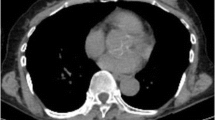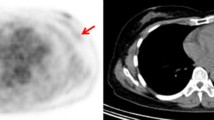Abstract
Purpose
The purpose of this study was to investigate the correlation of primary tumor FDG uptake to clinicopathological prognostic factors in invasive ductal carcinoma of the breast.
Methods
We retrospectively reviewed 136 of 215 female patients with pathologically proven invasive ductal breast cancer from January 2008 to December 2011 who underwent F-18 FDG PET/CT for initial staging and follow-up after curative treatment with analysis of estrogen receptor (ER), progesterone receptor (PR) and human epithelial growth factor receptor 2 (HER2). The maximum standardized uptake value (SUVmax) of the primary breast tumor was measured and compared with hormonal receptor and HER2 overexpression status.
Results
The high SUVmax of primary breast tumors is significantly correlated with the clinicopathological factors: tumor size, histologic grade, TNM stage, negativity of ER, negativity of PR, HER2 overexpression and triple negativity. The recurrent group with non-triple negative cancer had a higher SUVmax compared with the non-recurrent group, though no significant difference in FDG uptake was noted between the recurrence and non-recurrent groups in subjects with triple-negative cancer. Lymph node involvement was the independent risk factor for cancer recurrence in the multivariate analysis.
Conclusions
In conclusion, high FDG uptake in primary breast tumors is significantly correlated with clinicopathological factors, such as tumor size, histologic grade, TNM stage, negativity of the hormonal receptor, HER2 overexpression and triple negativity. Therefore, FDG PET/CT is a helpful prognostic tool to direct the further management of patients with breast cancer.


Similar content being viewed by others
References
Jung KW, Park S, Won YJ, Kong HJ, Lee JY, Park EC, et al. Prediction of cancer incidence and mortality in Korea, 2011. Cancer Res Treat. 2011;43:12–8.
Kim JE, Ahn HJ, Ahn JH, Yoon DH, Kim SB, Jung KH, et al. Impact of triple-negative breast cancer phenotype on prognosis in patients with stage I breast cancer. J Breast Cancer. 2012;15:197–202.
Yeo JS, Lee DS, Kang KW, Noh DY, Chung JK, Lee MC. Differential diagnosis of breast mass and staging of breast cancer using F-18-FDG PET. Nucl Med Mol Imaging. 1999;33:502–11.
Tantiwongkosi B, Yu F, Kanard A, Miller FR. Role of (18) F-FDG PET/CT in pre and post treatment evaluation in head and neck carcinoma. World J Radiol. 2014;6:177–91.
Marcus C, Whitworth PW, Surasi DS, Pai SI, Subramaniam RM. PET/CT in the management of thyroid cancers. AJR Am J Roentgenol. 2014;202:1316–29.
Ian JR, Fiona H, Malcolm RK. FDG-PETCT in the staging of localregional metastases in breast cancer. Breast. 2011;20:491–4.
Yoon JK. Clinical application of 18 F-FDG PET in breast cancer. Nucl Med Mol Imaging. 2008;42(Suppl):76–90.
Song BI, Hong CM, Lee HJ, Kang SM, Jeong SY, Kim HW, et al. Prognostic value of primary tumor uptake on F-18 FDG PET/CT in patients with invasive ductal breast cancer. Nucl Med Mol Imaging. 2011;45:117–24.
Kim JH, Yoo SW, Kang SR, Cho SG, Oh JR, Chong AR, et al. Prognostic significance of metabolic tumor volume measured by 18 F-FDG PET/CT in operable primary breast cancer. Nucl Med Mol Imaging. 2012;46:278–85.
Edge SB, Byrd DR, Compton CC, Fritz AG, Greene FL, Trotti III A, editors. AJCC cancer staging manual. 7th ed. New York: NY, Springer; 2010. p. 347–69.
Elston CW, Ellis IO. Pathological prognostic factors in breast cancer. I. The value of histological grade in breast cancer: experience from a large study with long-term follow-up. Histopathol. 1991;19:403–10.
Wolff AC, Hammond ME, Schwartz JN, Hagerty KL, Allred DC, Cote RJ. American society of clinical oncology/college of American Pathologists guideline recommendations for human epidermal growth factor receptor 2 testing in breast cancer. J Clin Oncol. 2007;25:118–45.
Pennant M, Takwoingi Y, Pennant L, Davenport C, Fry-Smith A, Eisinga A, et al. A systematic review of positron emission tomography (PET) and positron emission tomography/computed tomography (PET/CT) for the diagnosis of breast cancer recurrence. Health Technol Assess. 2010;14:1–103.
Simpson JF, Gray R, Dressler LG, Cobau CD, Falkson CI, Gilchrist KW. Prognostic value of histologic grade and proliferative activity in axillary node-positive breast cancer: results from the Eastern cooperative oncology group companion study, EST 4189. J Clin Oncol. 2000;18:2059–69.
Nguyen PL, Taghian AG, Katz MS, Niemierko A, Abi Raad RF, Boon WL. Breast cancer subtype approximated by estrogen receptor, progesterone receptor, and HER-2 is associated with local and distant recurrence after breast-conserving therapy. J Clin Oncol. 2008;26:2373–8.
Wang CL, MacDonald LR, Rogers JV, Aravkin A, Haseley DR, Beatty JD. Positron emission mammography: correlation of estrogen receptor, progesterone receptor, and human epidermal growth factor receptor 2 status and 18 F-FDG. AJR Am J Roentgenol. 2011;197:247–55.
Basu S, Chen W, Tchou J, Mavi A, Cermik T, Czerniecki B, et al. Comparison of triple-negative and ER+, PR+, HER2- breast carcinoma using quantitative F-18 FDG PET imaging parameters. Cancer. 2008;112:995–1000.
Groheux D, Giacchetti S, Moretti JL, Porcher R, Espié M, Lehmann-Che J, et al. Correlation of high 18 F-FDG uptake to clinical, pathological and biological prognostic factors in breast cancer. Eur J Nucl Med Mol Imaging. 2011;38:426–35.
Kim BS, Sung SH. Usefulness of 18 F-FDG uptake with clinicopathologic and immunohistochemical prognostic factors in breast cancer. Ann Nucl Med. 2012;26:175–83.
Vinh-Hung V, Everaert H, Lamote J, Voordeckers M, van Parijs H, Vanhoeij M, et al. Diagnostic and prognostic correlates of preoperative FDG PET for breast cancer. Eur J Nucl Med Mol Imaging. 2012;39:1618–27.
Koolen BB, Vrancken Peeters MJ, Wesseling J, Lips EH, Vogel WV, Aukema TS, et al. Association of primary tumour FDG uptake with clinical, histopathological and molecular characteristics in breast cancer patients scheduled for neoadjuvant chemotherapy. Eur J Nucl Med Mol Imaging. 2012;39:1830–8.
Berriolo-Riedinger A, Touzery C, Riedinger JM, Toubeau M, Coudert B, Arnould L, et al. [18 F] FDG-PET predicts complete pathological response of breast cancer to neoadjuvant chemotherapy. Eur J Nucl Med Mol Imaging. 2007;34:1915–24.
Kong EJ, Chun KA, Cho IH, Lee SJ. 18 F-FDG PET/CT with contrast enhancement for evaluation of axillary lymph node involvement in T1 breast cancer. Nucl Med Mol Imaging. 2010;44:170–6.
David G, Sylvie G, Jean-Luc M, Raphael P, Marc E, Jacqueline L, et al. Correlation of high 18 F-FDG uptake to clinical, pathological and biological prognostic factors in breast cancer. Eur J Nucl Med Mol Imaging. 2011;38:426–35.
Heudel P, Cimarelli S, Montella A, Bouteille C, Mognetti T. Value of PET-FDG in primary breast cancer based on histopathological and immunohistochemical prognostic factors. Int J Clin Oncol. 2010;15:588–93.
Ueda S, Tsuda H, Asakawa H, Shigekawa T, Fukatsu K, Kondo N, et al. Clinicopathological and prognostic relevance of uptake level using 18 F-fluorodeoxyglucose positron emission tomography /computed tomography fusion imaging (18 F-FDG PET/CT) in primary breast cancer. Jpn J Clin Oncol. 2008;38:250–8.
Haffty BG, Yang Q, Reiss M, Kearney T, Higgins SA, Weidhaas J, et al. Locoregional relapse and distant metastasis in conservatively managed triple negative early-stage breast cancer. J Clin Oncol. 2006;24:5652–7.
Rebecca D, Maureen T, Kathleen P, Wedad H, Harriet K, Carol S, et al. Triple-negative breast cancer: clinical features and patterns of recurrence. Clin Cancer Res. 2007;13:4429–34.
Bauer KR, Brown M, Cress RD, Parise CA, Caggiano V. Descriptive analysis of estrogen receptor (ER)-negative, progesterone receptor (PR)-negative, and HER2-negative invasive breast cancer, the so-called triple-negative phenotype: a population-based study from the California Cancer Registry. Cancer. 2007;109:1721–8.
Disclosure
Conflict of Interest
Il Jo, Seok Kil Zeon, Sung Hoon Kim, Hae Won Kim, Sun Hee Kang and Su Jin Kim declare that they have no conflicts of interest.
Ethics Statement
This study was approved by Institutional Review Board of Keimyung University Dongsan Hospital. All procedures followed were in accordance with the ethical standards of the responsible committee on human experimentation and with the Helsinki Declaration of 1975, as revised in 2000.
Author information
Authors and Affiliations
Corresponding author
Rights and permissions
About this article
Cite this article
Jo, I., Zeon, S.K., Kim, S.H. et al. Correlation of Primary Tumor FDG Uptake with Clinicopathologic Prognostic Factors in Invasive Ductal Carcinoma of the Breast. Nucl Med Mol Imaging 49, 19–25 (2015). https://doi.org/10.1007/s13139-014-0296-y
Received:
Revised:
Accepted:
Published:
Issue Date:
DOI: https://doi.org/10.1007/s13139-014-0296-y




